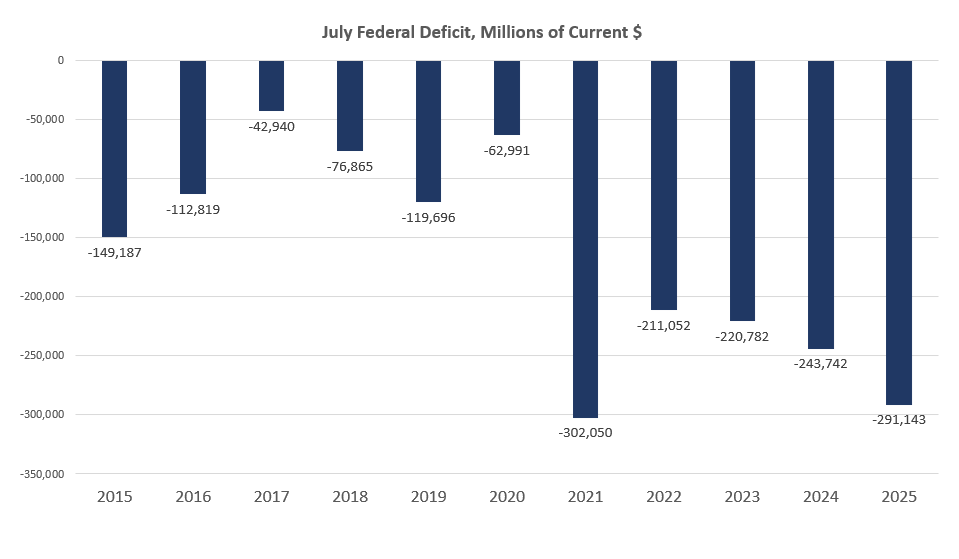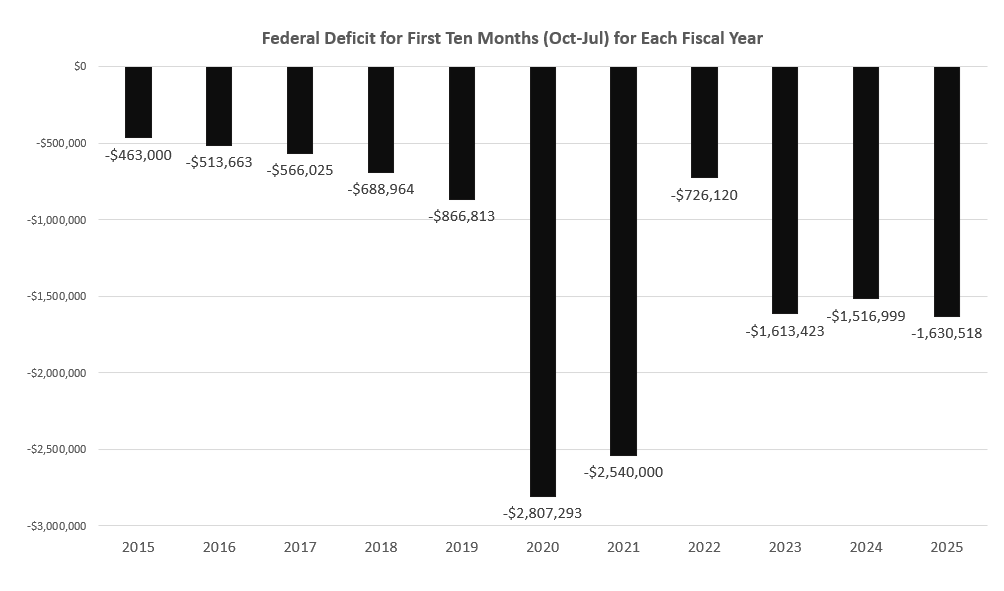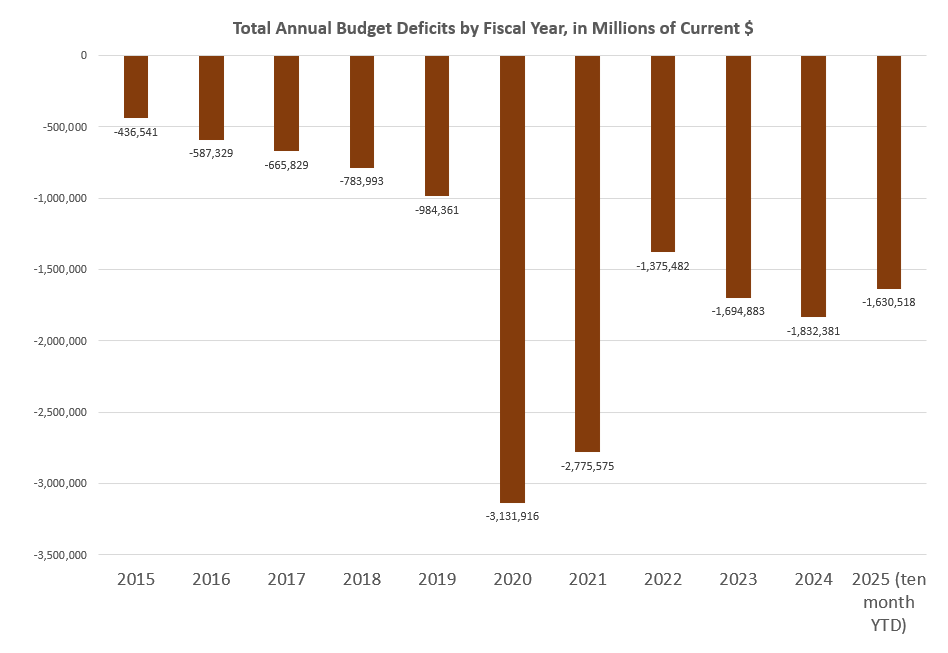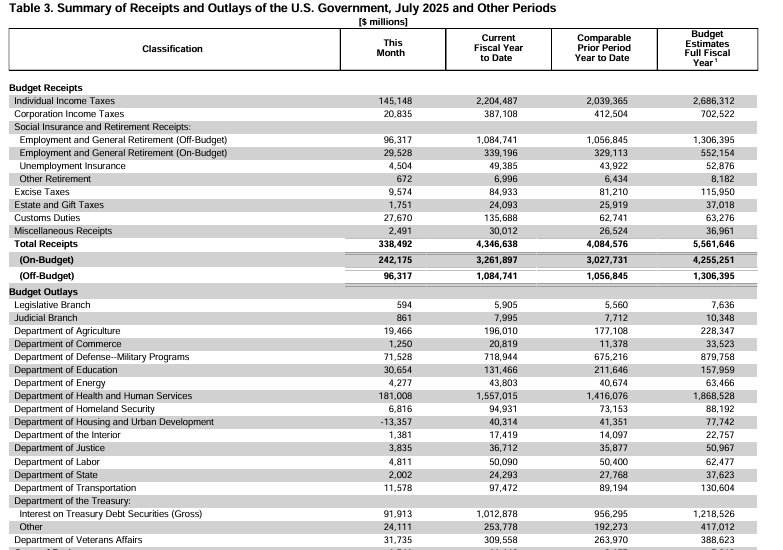During a July 20 interview, on CBS’ “Face the Nation,” Commerce Secretary Howard Lutnick made an unbelievable claim. He bragged that the US was collecting close to $30 billion a month in tariffs. He then went on to say: “You got to remember — this is going to pay off our deficit.”
No one who pays attention to federal fiscal policy actually believed this statement. And, if there was any doubt about the dubious claim, July’s Treasury report, released on Tuesday, makes it clear just how wrong Lutnick is. According to the July report, federal deficits are a long way from being paid off by new taxes on imports. Instead, federal deficits are getting bigger as Trump’s spending spree shows no signs of abating.
Specifically, July’s federal spending came in as the highest ever, topping even the grotesque spending of July 2020 during the dark days of the covid panic.

According to the Treasury, in July, the US government collected $338 billion. That’s up $8 billion from the previous July, so maybe Lutnick and Trump think this is very impressive and something to brag about. The problem is the US government also spent $629 billion during the same period. That is, Trump and Congress spent nearly two dollars for every dollar in tax revenue, for a monthly deficit of $291 billion. That’s up 19 percent over July of 2024 and is the largest July deficit in four years. July’s deficit even comes close to July 2021’s deficit of $302 billion, which occurred during a period of runaway covid spending.

In other words, the Trump-headed federal government is spending like it’s pandemic time all over again. Not surprisingly, then, the US federal debt continues to surge upward, with total debt passing the $37 trillion mark on Monday.
That’s what happens when the US government piles on an additional $291 billion in a single month, all while Lutnick is on a media tour claiming that tariffs will eliminate deficits.
We’re now ten months into the 2025 fiscal year, and the ten-month total is at a four year high, coming in at $1.6 trillion, an increase of 7.5 percent over fiscal year 2024. Nearly half of that deficit comes from the six months since Trump was sworn in as president in late January.

Looking ahead to the rest of the current fiscal year—which ends on September 30—the total deficit is poised to surpass 2024’s FY deficit of $1.8 trillion. If August and September are anything like July, the total FY deficit will even exceed $2 trillion, making 2025 the worst year for deficits since covid.

Importantly, the report also showed that as total debt levels surge, enormous amounts of tax dollars must go to paying interest on the debt. Of the $338 billion in revenue collected during July, $91 billion, or 27 percent, went to just paying interest on the national debt. That means more than one in four dollars in revenue went not to any infrastructure or anything that today’s taxpayers might actually benefit from. No, more than a quarter of tax revenue is going to pay off lost wars like Iraq and Afghanistan, or to other boondoggles.

Amazingly, though, many of Trump’s supporters still insist that the Trump administration is filled with fiscal hawks. Yet, the much-touted Trump budget cuts have amounting to a “nothingburger” when it comes to federal spending. DOGE—which has admittedly done some good work in cutting dangerous propaganda factories like USAID and various NGOs—has made no meaningful changes to overall spending. The administration plans to send ever larger amounts of taxpayer dollars to the State of Israel and to the unelected dictators who run the Ukrainian government.
We can also expect these ongoing deficits to drive the president to apply even more pressure to the Federal Reserve to lower short term-interest rates. Part of the reason that so much of federal revenues must now go to debt service is the rising cost of federal debt. As yields on Treasurys have risen, so has the monthly bill on paying the federal debt. In his various rants against Jerome Powell and the Federal Reserve, Trump has complained that new federal debt is too expensive, and the US government has been spending too much on interest. Trump has explicitly stated that the central bank ought to force down interest rates so debt is cheaper.
It’s easy to see why Trump would be preoccupied with this. His administration has gone all-in on spending at levels not seen since the covid era. Trump insists that the US government is more or less in a golden age of prosperity, yet the federal government is spending like the US is in the midst of a crisis. This spending will certainly not be reined in by Trump’s “big, beautiful bill” which further inflates federal spending, and contains only some token budget cuts.
Going forward, these sorts of deficits mean more monetary inflation—and thus more price inflation—and a continuation of the fiscal status quo. DOGE has failed in its stated mission. Trump is no fiscal hawk. The Republican leadership in Congress—with Trump’s encouragement—will keep spending at record-breaking levels. We can expect more of this throughout the rest of this administration.


